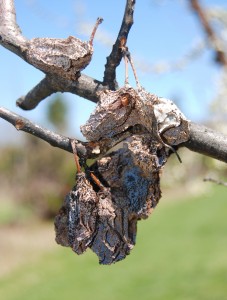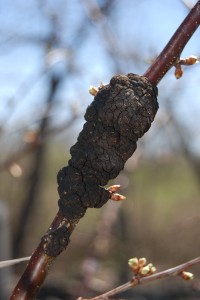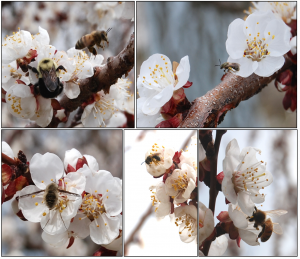Wednesday, 14 May 2014: Petal fall is a really critical time for apple disease control. Trees are rapidly generating new disease-susceptible terminal leaves, and fruitlets are at peak susceptibility for infection by fungi causing scab, rust, blossom-end rots, moldy core, and “natural” fruit russet. At the same time, both leaves and fruit are highly susceptible to injury by inappropriate chemical mixtures. Following is a somewhat lengthy run-down of apple disease concerns at petal fall:
1. Apple scab is still the #1 concern at petal fall. Ascospore release from fallen leaves is usually completed during bloom (except in years with limited rainfall prior to bloom). However, at petal fall no one can yet be certain if fungicides applied prior to bloom were completely effective. Even where prebloom scab control was good, just a few new scab lesions per acre (which would be difficult to find via scouting) can generate enough conidia to cause significant losses by the end of summer. Therefore, good scab protection must be maintained for at least 14 days after petal fall, by which time the effectiveness of prebloom scab control can be verified and fruitlets will be somewhat more resistant to scab infection.
2. Fire blight blossom infection remains a threat if late flowers are still opening on one-year old wood in bearing orchards or in orchards that were just planted this year. It may be necessary to include streptomycin in petal fall sprays if bearing trees are still producing a few new flowers and if the blossom blight models indicate infection is likely. Those who question whether a few late flowers really warrant another strep spray may wish to estimate how many flowers are present per tree, then visualize the cost of having employees prune out all of those flower clusters. If those late flowers get fire blight, an equivalent amount of labor will be required to remove the resulting fire blight strikes.
3. Rust diseases of concern are cedar apple rust and quince rust, both of which can cause fruit infections at petal fall even though the risk of fruit infections drops off quickly after petal fall. The DMI fungicides are the best for controlling rust diseases, but mancozeb, QoI fungicides, and SDHI fungicides will all provide adequate protection if applied ahead of potential infection periods.
4. Powdery mildew can explode on terminal leaves that are not protected with a mildewcide at petal fall. Failure to control mildew at petal fall and first cover will ensure high disease pressure through summer and abundant inoculum for next year.
5. Blossom-end rots caused by various fungi usually result from infection just before or during petal fall because several of the causal fungi are adept at infecting senescent flower petals and moving from there into the sepals and fruitlets. Information on these diseases was summarized in a 2005 article in Scaffolds Fruit Journal. Captan and Topsin M have been very effective against blossom-end rot fungi in the past. Recent work in veg crops suggests that the new SDHI fungicides may also control Sclerotinia sclerotiorum, one of the pathogens that causes blossom-end rot. However, using expensive fungicides solely to target blossom-end rots is probably unwarranted because these diseases are sporadic and rarely infect a high percentage of fruit when they do appear in years with warm wet weather at petal fall.
6. Moldy core is caused by many different fungi and occurs when fungi enter the seed cavities of apples via the floral tube (photo). Most infections occur during late bloom and petal fall, when fungal spores can get washed into the floral tubes on cultivars that tend of have open sinuses at the calyx end. Fungicides are ineffective against this disease because most of the moldy core we see is caused by Alternaria species that are difficult to control with fungicides and because spores are protected from fungicide as soon as they are washed into the floral tubes.
7. “Natural” fruit russet on russet-susceptible cultivars such as Golden Delicious is largely attributable to endemic yeasts and a yeast-like fungus (Aureobasidum pullulans) that colonize fruit during wet weather between late bloom and first cover. Populations of these russet-inducing organisms can be suppressed with contact fungicides, and perhaps by QoI fungicides as well. However, research conducted at the Hudson Valley Lab last year suggests that suppressive sprays are most effective when applied just ahead of extended wetting periods, probably because populations of the russet-causing organisms can bounce back quickly as spray residues are depleted. Research in North Carolina has shown that Apogee applications may also help to suppress russet (see related Scaffolds article).
8. Chemically-induced fruit russet (i.e., phytotoxicity) sometimes results from applications of captan mixed with other agrochemicals at petal fall and/or first cover. As noted in an article in Scaffolds (24 March 2014, pg 6), we suggest that growers avoid using captan in their petal fall and first cover sprays because of risks that including captan in those sprays may exacerbate fruit russetting and/or lenticel roughening. However, omitting captan at petal fall may allow more blossom-end rot infections because captan is broadly effective against the various pathogens in the blossom-end rot complex whereas mancozeb, Polyram, and the DMI fungicides are not. Those wishing to avoid captan at petal fall should consider either a mancozeb-Flint mixture or a mancozeb-Topsin M mixture so as to maintain coverage against blossom-end rots. The former may still be weak against S. sclerotiorum, but the latter will probably be weak against both scab and mildew because most populations of these pathogens are resistant to Topsin M.
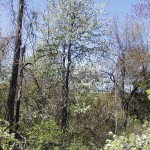
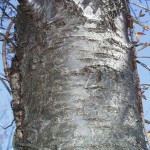



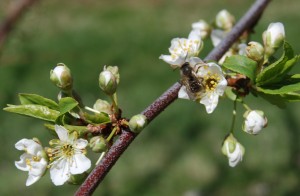 ‘Early Golden’ plum in bloom at the Hudson Valley Lab at noon on April 24.
‘Early Golden’ plum in bloom at the Hudson Valley Lab at noon on April 24.